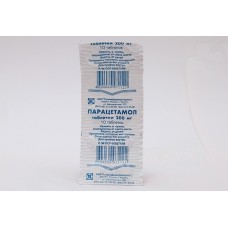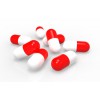Expiration date: 05/2026
The composition and form of issue:
Tablets. 1 tablet contains:
paracetamol 0.2 g or 0.5 g
excipients: potato starch stearic acid starch syrup gelatin or PVP
or in the contour bezgyachakova packing 10 PCs. in cardboard pack 1, 2, 3, 4, or 5 packs (or packs) or polymer banks in the 10, 20, 25, 30, 40, 50 or 60 PCs the paper cartons 1 Bank (or without a tutu).
Description of dosage form:
Tablets are white or white with a creamy tint of color, flat-cylindrical shape with chamfer and risque.
Characteristic:
Paracetamol-UBF is an analgesic non-narcotic drug.
Indications:
- moderate or mild pain syndrome (headache, toothache, migraine, sore throat, neuralgia, myalgia)
- algodismenorrhea
- increased body temperature in colds and other infectious and inflammatory diseases.
Contraindications:
- hypersensitivity to paracetamol
- elderly (over 65 years)
- children under 2 years
- severe impairment of liver or kidney function
- genetic deficiency of glucose-6-phosphate dehydrogenase
- blood diseases (hemophilia).
With caution:
- Gilbert's syndrome (constitutional hyperbilirubinemia)
- congenital hyperbilirubinemia (Dubin-Johnson and Rotor).
Use during pregnancy and lactation:
It is undesirable to use during pregnancy and during breastfeeding.
Side effect:
Allergic reactions (rash, itching, angioedema, urticaria), anemia, thrombocytopenia, leukopenia, agranulocytosis. With long-term administration in high doses, hepatotoxic and nephrotoxic effects, renal colic, hemolytic anemia, aplastic anemia, methemoglobinemia, pancytopenia are possible.
Drug interaction:
Stimulants of microsomal oxidation in the liver (phenytoin, ethanol, barbiturates, flumecinol, rifampicin, phenylbutazone, tricyclic antidepressants) increase the formation of hydroxylated active metabolites, which makes it possible to develop severe intoxication with small overdoses of paracetamol. Ethanol contributes to the development of acute pancreatitis. Inhibitors of microsomal oxidation (including cimetidine) reduce the risk of hepatotoxic action. Reduces the effectiveness of uricosuric drugs.
Dosage and administration:
Inside, usually 500 mg (1 table.) 2-3 times a day. The maximum single dose for adults-1 g (2 table. 500 mg or 5 table. 200 mg), daily - 4 g (8 table. 500 mg or 20 tab. 200 mg). Duration of administration as an antipyretic - no more than 3 days, as an analgesic-no more than 5 days.
In patients with impaired liver or kidney function, with Gilbert's syndrome, in elderly patients, the daily dose should be reduced (increased interval between doses).
For children — 10-15 mg / kg body weight every 6 hours. Children are recommended to use children's dosage forms.
Overdose:
Symptoms: pallor of the skin, nausea, vomiting, stomach pain, after a day or two, signs of liver damage are determined. In severe cases, liver failure, encephalopathy and comatose state, hepatonecrosis develop.
Treatment: the victim should do gastric lavage, prescribe adsorbents (activated carbon) and consult a doctor.
Special instruction:
With caution used in patients with impaired liver or kidney function. The risk of hepatotoxic action increases with the simultaneous administration of phenytoin, ethanol, barbiturates, flumecinol, rifampicin, phenylbutazone, tricyclic antidepressants and other inducers of microsomal liver enzymes.
In order to avoid toxic liver damage, paracetamol should not be combined with the intake of alcoholic beverages, as well as taken by persons prone to chronic alcohol consumption. The risk of liver damage increases in patients with alcoholic hepatosis.




